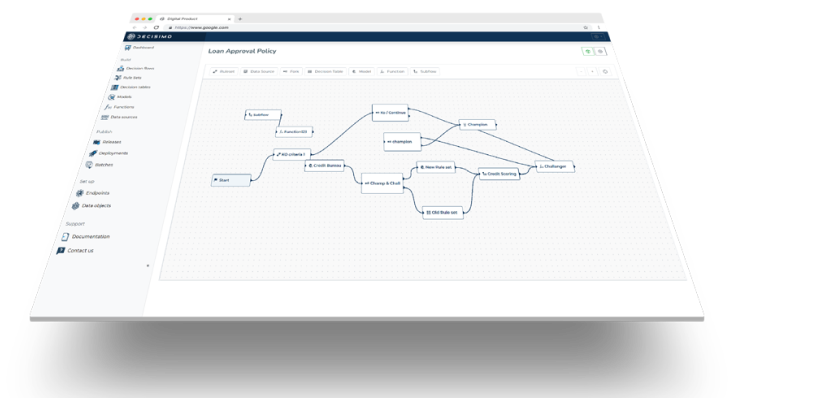Implementing scorecards in rule engines - Decisimo
Published on: 2024-08-10 18:38:55
Implementing scorecards in rule engines is a critical process in automated decision-making, especially in sectors like credit lending. Scorecards help in evaluating various factors to make informed decisions. This guide provides a comprehensive overview of how to implement a scorecard, using a credit lending scorecard example, with bins using rule sets, decision tables, and scorecard modules.
Example Scorecard: Credit Lending
We will use a hypothetical scorecard for credit lending based on criteria like sex, marital status, education level, delinquency level, number of repaid loans, and social network presence. The total score will determine the creditworthiness of an individual.
| Criteria | Category | Points |
|---|---|---|
| Sex | Female | 10 |
| Male | 8 | |
| Marital Status | Single | 5 |
| Married | 10 | |
| Divorced/Widowed | 7 | |
| Education Level | High School or Lower | 5 |
| College/University Graduate | 10 | |
| Postgraduate | 15 | |
| Delinquency Level | No Delinquency | 15 |
| 1-2 Late Payments | 10 | |
| 3+ Late Payments | 0 | |
| Number of Repaid Loans | 0-1 | 5 |
| 2-3 | 10 | |
| 4+ | 15 | |
| Social Network Presence | Low (Rarely Active) | 5 |
| Medium (Occasionally Active) | 10 | |
| High (Very Active) | 15 |
Part 1: Using Rule Sets for Scorecard Implementation
Implementing Each Bin as a Rule:
To effectively implement the scorecard using rule sets, consider the following steps:
- Rule Development for Each Criterion: Configure individual rules corresponding to each scorecard criterion. For example, assign 10 points for 'Female' and 8 points for 'Male' under the 'Sex' category.
- Points Aggregation: The rule engine aggregates points across all criteria to calculate a total score, reflecting the applicant's credit profile.
- Systematic Validation: Establish a validation process to ensure each rule accurately represents its respective scoring criterion.
Challenges in Rule-Based Implementation:
Implementing scorecards via rule sets presents several challenges:
- Complexity Management: Handling a large number of rules, especially for nuanced criteria, can be complex and prone to errors.
- Consistent Rule Management: A robust framework is necessary for managing and maintaining consistency among rules.
- Regular Updates and Testing: Rules require updates and testing to align with evolving criteria or scoring strategies, ensuring the engine's reliability.
Part 2: Utilizing Decision Tables for Scorecard Implementation
Decision Table for Each Category:
When implementing scorecards using decision tables, consider these key steps:
- Separate Tables for Each Criterion: Create an individual decision table for each category such as 'Marital Status,' with rows for 'Single,' 'Married,' etc., and corresponding points.
- Scoring Logic Integration: Configure each table to output points based on the input criteria, which are then summed up to determine the total score.
Advantages of Decision Table Implementation:
Decision tables offer several benefits in scorecard implementation:
- Enhanced Clarity: They provide a clear and concise format that reduces the potential for errors in scoring logic.
- Simplified Maintenance: Updating scorecard logic is more straightforward, facilitating easier maintenance of individual aspects.
Part 3: Implementing Scorecards with a Scorecard Module
Using a Dedicated Module:
To implement a scorecard using a dedicated module, follow these guidelines:
- Direct Input of Criteria: Enter the scorecard's bins and scoring rules directly into the module for automated processing.
- Automated Score Calculation: The module automatically calculates the total score based on set criteria, streamlining the scoring process.
Best Practices for Scorecard Module Implementation:
Maximize the effectiveness of your scorecard module with these best practices:
- Leverage Built-in Functionalities: Utilize the module’s features for efficient and accurate scorecard implementation.
- Ensure Regular Updates: Keep your scorecard up-to-date with changing criteria or scoring methods to maintain accuracy and relevancy.
Conclusion
Implementing a scorecard in a rule engine can be approached in several ways, each with its own strengths. Whether using rule sets, decision tables, or a dedicated scorecard module, it is crucial to choose the method that aligns best with your organizational needs and the complexity of the scorecard.
Decisimo offers a robust rule engine that can be configured to implement scorecards in a variety of ways. To learn more about Decisimo’s rule engine and how it can help you automate your decision-making, contact us today.


